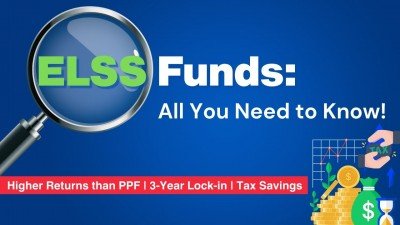
Is ELSS Mutual Funds a Smart Tax-Saving Investment Option? The Smart Investor's Guide
Posted By: Blog

As we kick off the new financial year, it's time to start planning your investments and taxes. Today, let's explore a tax-saving option called ELSS, or Equity-linked savings scheme, that offers a unique opportunity for investors to reap double benefits.
Are you searching for a fascinating product that offers dual benefits? Look into ELSS, an investment option that allows you to both appreciate your capital and minimize your taxes. This intriguing product falls under section 80C of the Income Tax Act (old regime). However, if you've opted for the new regime, you may need a different option.
In the previous system, this was just another way to reduce your tax burden. ELSS, along with PF, PPF, fixed deposits, insurance premiums, and more, offers you various options to save on taxes. However, let me explain why ELSS mutual funds are the smarter choice.
What is ELSS (Equity Linked Saving Scheme)?
ELSS, short for Equity Linked Saving Scheme, refers to a mutual fund scheme that invests in various portfolios and offers tax benefits. Under the regulations set by SEBI, every mutual fund company can introduce an ELSS scheme.
Rules To Be Followed In ELSS Schemes
ELSS Has a 3-Year Lock-in Period
ELSS schemes must adhere to specific rules. One such rule is that the investors' funds are locked in for three years.
ELSS Has a Diversified Portfolio
The majority of these funds are presently held in a well-balanced portfolio. This allows investors to take part in the wider stock market.
ELSS Has both Dividend and Growth Options
Additionally, these funds offer both a dividend option and a growth option. Since the dividend option is currently subject to taxes, we suggest that investors consider the growth option. These are straightforward methods to explore various ELSS mutual fund schemes, which are offered by almost every mutual fund company, albeit under different names.
Comparison Between ELSS And Other Investment Options
Wondering how to compare ELSS with other investment options? We've already done the legwork by comparing the top four ELSS schemes with the reliable Public Provident Fund. Which is a stable tax-saving option that investors have used for a long time. We used an 8% rate for the Public Provident Fund and considered a SIP of 10,000 for the ELSS schemes. This SIP was done every year, totaling 1.2 lakhs over 15 years.
The investor made a significant financial commitment with a monthly investment of 18 lakhs in these schemes. Comparing this to the investment in PPF, where the same amount was invested for 15 years, the results are truly impressive.
Not only did the investment help them save on taxes, but it also built a corpus of approximately 34 lakhs. Remember, the PPF corpus is exempt from taxes, giving you a major advantage. So, when it's time for maturity, you can withdraw the money tax-free. It's all yours to keep. On the other hand, mutual funds invested through SIP for 15 years will have a capital base by the end of the 15th year.
Their investment saw a significant increase in value, ranging from 64 lakhs to 67 lakhs, nearly twice the returns one could have received from PPF. Reflecting on the past 15 years, starting from 2024 and moving backward, it's evident that 2009 was a challenging time during the global financial crisis, posing risks for those in the stock market. It's crucial to consider the fluctuations in the market as a whole.
Certainly, it is important to consider that after 15 years, if you withdraw the 67 lakhs gained from your investment, you will be subject to a 10% tax. Hence, a taxation aspect is involved when it comes to mutual funds. However, even after paying the tax, your profits remain considerably higher. Now, does this imply that all investors should completely forsake PPF and solely invest in ELSS mutual fund schemes?
Things To Know About ELSS Before Investing
ELSS Is Good For Long-Term Wealth Creation
When it comes to long-term wealth creation, ELSS stands out as an excellent option. It's crucial to remember that these investments are tailored for individuals looking at a 5-year, 10-year, or 15-year timeframe, rather than quick gains, given their connection to the stock market. The value of investments is subject to fluctuations over time.
If taking risks isn't your thing, ELSS might leave you feeling a bit unsettled. But if you're all about stashing money away and forgetting about it like in your PPF, then ELSS is a smart investment to consider.
ELSS Has The Shortest Duration For Maturity
ELSS has the quickest maturity period, allowing you to withdraw your money in just three years. On the other hand, with PPF, you can only access your funds after 15 years. ELSS is the shortest holding period for all tax-saving investments, enabling you to retrieve your money within three years. If you've earned good profits, why not take advantage of it?
ELSS Has An Sip Option And It Is Easy To Set Up
This product is incredibly user-friendly to set up and start using. You can easily set up a monthly SIP, and the amount will be automatically deducted from your account. Unlike other investments such as PPF or NSEs, where you have to make an effort to transfer the money, here it gets debited automatically. So, you can conveniently do an SIP on your ELSS.
ELSS Has The Potential To Generate Much Higher Returns Over The Long Term
Don't forget, that these products are tied to the market, and with India emerging as a strong player in the global economy, it's wise to consider investing in ELSS if you have a 5 to 10-year horizon. Beyond just market returns, remember that ELSS can also provide tax benefits.
That's why I believe it's important to consider investing a portion of your tax-saving money in ELSS investments. It's worth noting that the maximum amount available for tax deduction under section 80C is 1,50,000. Within this limit, I strongly recommend allocating a specific amount towards ELSS funds.
For the complete video experience, click on this link
Category Finsherpa | Tags


